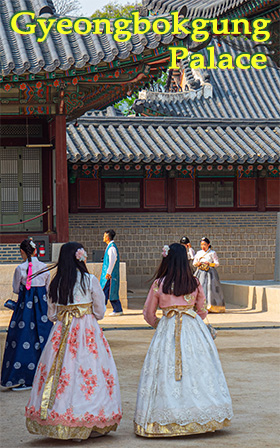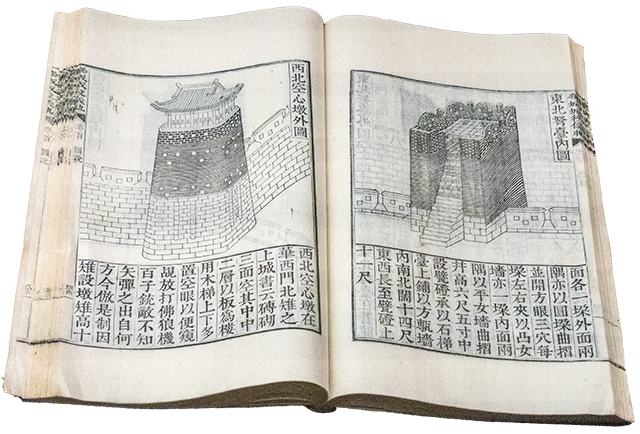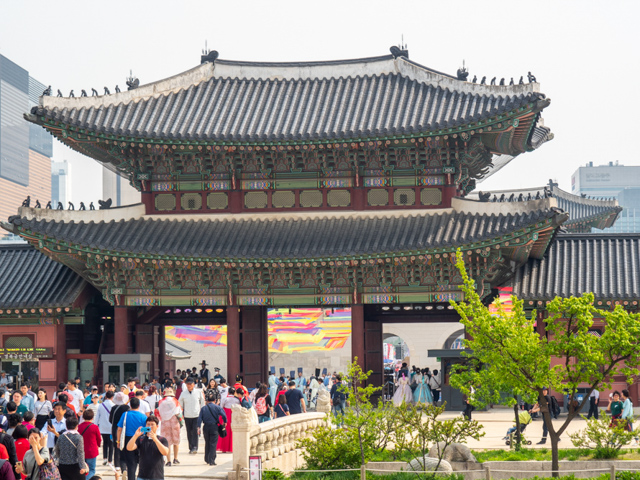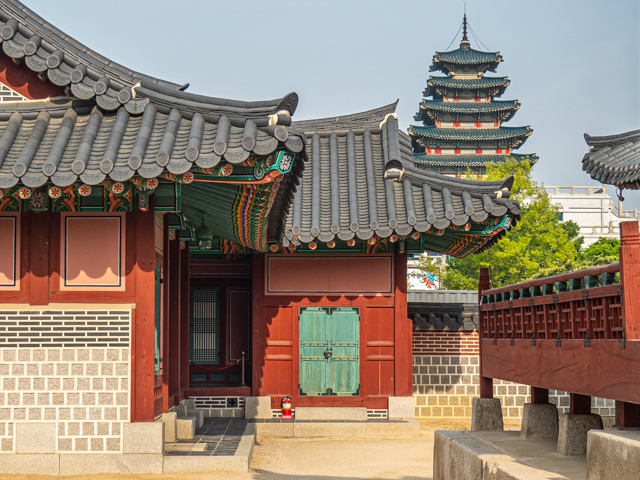


|
Gyeongbokgung, established in 1392 to be the principal palace for the Joseon Dynasty(1392-1910), was destroyed in 1592 by a Japanese force lead by Toyotomi Hideyoshi. It remained in ruins until a restoration program commencing in 1867. About 500 buildings were restored or newly built in the project. The palace suffered considerable damage during the Japanese occupation(1910-1945). In 1915, 90% of the buildings were demolished to hold a Korean Product Promotion Fair. Another project to restore the palace was launched in 1990. |
I took the Metro to Gyeongbokgung Station and following the well marked signage I emerged from underground in front of the National Palace Museum of Korea. From here you can enter the Gyeongbokgung Palace grounds.
Before entering the palace grounds I visited the National Palace Museum. The museum features artifacts and records from the Josen Dynasty (1392-1897).
That the emphasis should be on the Josen Dynasty is logical as Seoul was its capital. In Gyeongju, former capital of the Silla Dynasty, the emphasis is on the Silla.
Over 40,000 artifacts from the Josen Dynasty are on display. Amongst the items on display are bamboo books; red lacquered Royal furnishings; Josen ceremonial robes; dye templates for embroidery; Royal seals; decorated broaches and scolls.

Many of the exbits, for example, the Royal Protocols, are concerned with record keeping.
Uigwe is a series of comprehensive records documenting procedures of court cermonies and state events such as weddings, funerals, anniversaries, or major construction projects.

Contents included written accounts of decision-making processes at court, documents related to administration and lists of participating officials, craftsmen as well as illustrated descriptions of ceremonial items and procession arrangements. All surviving copies date from after the Japenese Invasion(1592-1598). Uigwe was inlisted as the UNESCO Memory of the World in 2007.
I entered the palace grounds from the Natonal Palace Museum which placed me between the Genunjeongmun and Heungnyyemum Gates.


Having passed through the Geunjeongmun Gate the first thing I noticed was many people, particularly women, wearing Korean traditional dress, the hanbok. Did it have some to do with Children's Day on the next day or is it something people do on a Saturday in Seoul.


Right in front me was the most important building in Gyeongbokgung Palace, Geunjeongjeon.
Geunjeongjeon is the most lavishly decorated building in the palace grounds. It was here where Josen rulers were coronated, where royal, state events, cabinet meetings and the reception of foreign envoys occurred. It was also where the final state examinations were held.

Right behind Geunjeongjeon is the almost as important Sajeongjeon Hall. The palace has a linear layout with minor building to the side.
This was the main council hall of the Josen rulers and the place where everyday administrative duties were performed including morning assemblies with high ranking officials. It is also the hall that housed the throne.

Behind the throne during the period of the Joseon Dynasty is a highly stylise scene (Irwolgonryundo) depicting a burning red sun, a white full moon and five peaks and two cascading streams flanked on both sides, by a pair of conifers. The Sun and Moon symbolise the King and Queen and the five peaks a mythical place. Locating the throne in front placed the King at the center of the Universe.
West of Sajeongjeon Hall is Cheonochujeon. This smaller building had floor heating. The King would use it as an office during winter in an attempt to cut down costs.

Ladies wearing the traditional Korean dress, the hanbok, in the vicinity of Gangyneonjeon Hall. Hanboks can be hired at various shops in Seoul. People wearing them, Korean and foreigner are allowed into palace grounds for free.

Gangyneonjeon Hall was used by the Josean kings as a living quarters. Sometimes it would be used to have unofficial meetings with cabinet ministers.

Directly behind Gangyneonjeon Hall is the offical residence of Joseon queen consorts, Gyotaejeon. The queen consort was responsible for the mangement of royal household affairs.

At the rear of Gyotaejeon is a terraced artificial mound called Amisan Mountain. On it are four chimneys designed to emit smoke from the floor heating system (ondol) of the Gyotaejeon. The chimneys are hexagonal and engraved with various designs such as crane, bat, phoenix, pine, vine, Korean apricot, chrysanthemum, herb of immortality, rocks, bird and deer.

Moving northwards from the Gyotaejeon I came upon the Jipgyeongdang, living quarters of court ladies and concubines in Gyeongbok Palace. From here the pagoda of the National Folk Museum of Korea can be seen.

Being near closing time for the Folk Museum and blocked from Hyangwonjeong Pavilion by a partition, my visit to Gyeongbokgung Palace had come to an end.

Visiting the National Palace Museum and Gyeongbokgung Palace on the same day is a very full day. Some might prefer to spread the visits over two days.